Architectural Color Study Project #4 Step by Step
Starting in Class Wednesday, October 4
Due Printed out Wednesday, October 11
The geometry of negative space balances that of positive space. Colors also balance one another, affecting the viewer’s perception of neighboring colors. By linking these two critical aspects of an image, the artist visualizes the intrinsic interconnectedness of shape and color.
Import your favorite sketch done at the Highline concentrating on one and two-point perspective into Illustrator. Represent all aspects of positive and negative spaces in color forms focusing on your study of hue, intensity, temperature, saturation, light and shadow.
Adobe Illustrator is an advanced vector-based software. So, unlike Photoshop’s pixel-based format, it uses math to create vector graphics. In Illustrator, a line is composed of two dots connected by a computer algorithm, instead of just a line of pixels. Because of this, Illustrator is used often to create logos or anything that may need to be printed or displayed at different sizes. A vector graphic will never lose its quality if it’s scaled up or down. Illustrator will also give you a better print output since it’s not resolution dependent. A drawback of Illustrator is that it can’t be used easily to modify images that are already created, since there are limited filters and image editing tools available to you.
Illustrator Skill Sets: Interface, Preferences, Page set up, Art Board, Menus, Grid/Rulers, Navigation, Zoom, Input/Output, Paths – pen tool/Shape tool/pencil tool, Bezier handles, Adding and Deleting anchor points
Drawing and Observational Skill Sets: One-point and two-point perspective, architectural form and space, color theory vocabulary (hue, value, intensity, saturation, light value), simplifying shape, value reduction, positive and negative space, vanishing point, horizon line
References and Artists: Piet Mondrian, Wassily Kandinsky, Richard Diebenkorn, Fairfield Porter, Jacob Lawrence.
Materials: sketchbook drawings of the highline (sketchbook, pens, pencils), Illustrator (laptop computers)
STEP 1
 Create a new project, ready for print. Must be 11”x17”, make sure the color mode is set to CMYK.
Create a new project, ready for print. Must be 11”x17”, make sure the color mode is set to CMYK.
STEP 2
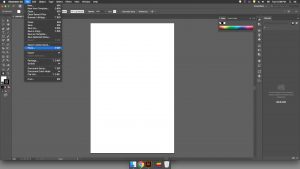 Go to File -> Place to open up finder. Navigate to your image, and hit Place. Then click to place your image.
Go to File -> Place to open up finder. Navigate to your image, and hit Place. Then click to place your image.
STEP 3
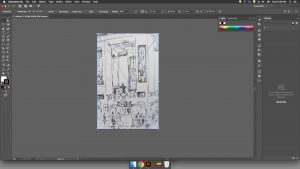 Resize your drawing to fit artboard. Make sure you are set to the selection tool (hotkey V). Click on the anchor and hold shift while you drag it to size. Snap one corner to the corner of your artboard, then do the same with the diagonally opposite corner.
Resize your drawing to fit artboard. Make sure you are set to the selection tool (hotkey V). Click on the anchor and hold shift while you drag it to size. Snap one corner to the corner of your artboard, then do the same with the diagonally opposite corner.
STEP 4
 Lock down the drawing layer. The layer menu can be found by going to the tool bar next to the library panel and selecting the icon that looks like two squares on top of each other.
Lock down the drawing layer. The layer menu can be found by going to the tool bar next to the library panel and selecting the icon that looks like two squares on top of each other.
To lock the layer click the space between the eye icon and the layer name. Create a new empty layer by clicking the folded piece of paper at the bottom of the layers panel.
STEP 5
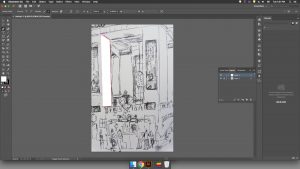 Select the pen tool to make a shape. To do this, you click to drop an anchor point. Click again elsewhere to make a second anchor point. The line between these is called a path. Continue to drop anchor points until you have outlined the shape you want.
Select the pen tool to make a shape. To do this, you click to drop an anchor point. Click again elsewhere to make a second anchor point. The line between these is called a path. Continue to drop anchor points until you have outlined the shape you want.
To draw a shape next to another shape, make sure you snap your anchor points. If you don’t, you will have white space between the shapes. If you are having trouble snapping, make sure to check and see if your snapping is on. Go to View -> Snap to Point. If there is not a check mark next to it, it is off. Click on it to turn it on.
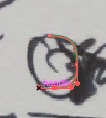 To make a curved shape you will need to activate your handles. To do so, you simply need to drag while you are clicking to drop your anchor point. This can be difficult to get right at first but I have some resources on my blog that I recommend for practice.
To make a curved shape you will need to activate your handles. To do so, you simply need to drag while you are clicking to drop your anchor point. This can be difficult to get right at first but I have some resources on my blog that I recommend for practice.
STEP 6
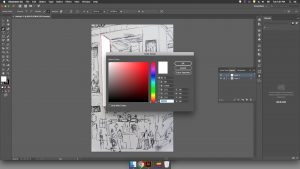 To change the color of your shape, select the solid color chip to open up the color picker. Then select the color you want your shape to be. This is called the Fill color. To change the outline of your shape, also known as the Stroke, select the color chip with the square in the middle.
To change the color of your shape, select the solid color chip to open up the color picker. Then select the color you want your shape to be. This is called the Fill color. To change the outline of your shape, also known as the Stroke, select the color chip with the square in the middle.
If you want to remove the fill or the stroke from your shape, you can select the square with the red line through it below the color chips.
STEP 7
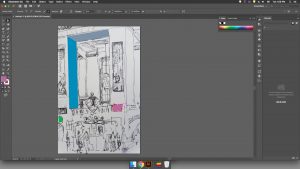 To edit a shape, you will need to go to the direct selection tool, which is the white arrow. This tool will allow you to change the position of anchor points and handles, so you can make your shape exactly how you want it.
To edit a shape, you will need to go to the direct selection tool, which is the white arrow. This tool will allow you to change the position of anchor points and handles, so you can make your shape exactly how you want it.
STEP 8
Repeat 5 through 7 until complete.
For this project please cover the entire canvas with color. No white spaces.
Some other tools you might want to look at include:
The Hand Tool which allows you to move your project around
The Shape Tool which creates exact shapes
The Eyedropper Tool which changes the color of selected shapes to the color the eyedropper is on
The Pencil Tool and the Paintbrush tool which freeform draws paths
The Eraser Tool which freeform erases selected objects.


